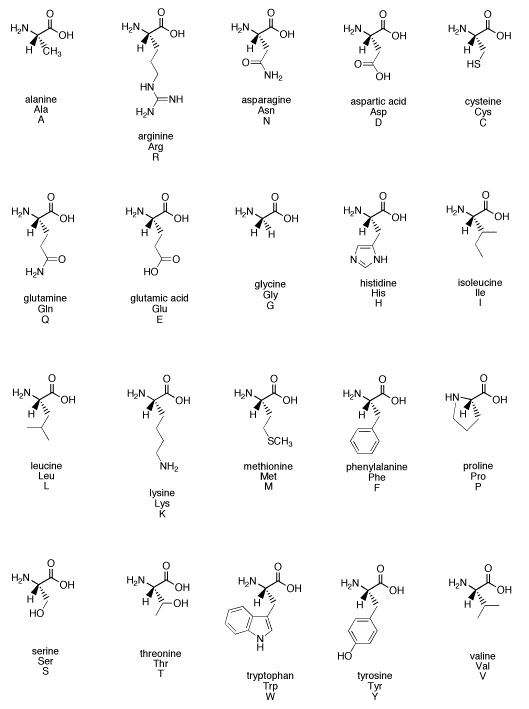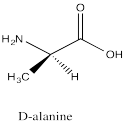5.12: Biological Building Blocks- Amino Acids
- Page ID
- 191227
One of the most important classes of biological chiral compounds is the family of amino acids. Amino acids are building blocks that are used to make peptides and proteins. Peptides can be used as hormones, carrying messages throughout the body. Proteins can be used as factories to carry out transformations, such as the formation of a neurotransmitter or the degradation of a toxin. The structure of peptides and proteins depend on the structures of the amino acids that make them. In turn, these shapes determine into what receptors peptide-based hormones can fit, and also what substrates protein-based enzymes can accept.
- Almost all of the naturally-occurring amino acids are chiral. In general, these compounds all have the same L-configuration.
- The peptides and proteins made from amino acids are therefore chiral as well.
- Chirality plays an important role in recognizing substrates and producing other chiral products.

Go to Animation SC12.1. A three-dimensional model of L-leucine.
A few bacteria and fungi are capable of making the opposite enantiomer of the normal amino acids. In those compounds, the amino group and the hydrogen on the chiral carbon have switched positions.
Go to Animation SC12.1. A three-dimensional model of D-alanine.
Amino acids get their name from two "functional groups" or groups of atoms common to all these compounds. One of these groups is a carboxylic acid, the (C=O)OH on each amino acid. Later, we will look at how carboxylic acids can donate protons. The other common group is an amine, the NH2 group connected to a tetrahedral carbon in most of these compounds. Later, we will see how amines can accept protons. In general, amines are bases.
Exercise \(\PageIndex{1}\)
One of the amino acids is not chiral. Which one?
- Answer
-
Glycine
Exercise \(\PageIndex{2}\)
One of the amino acids has an enantiomer and also has diastereomers. Which one? Draw both diastereomers.
- Answer
-

Exercise \(\PageIndex{3}\)
One of the amino acids does not have an NH2 group. Which one?
- Answer
-
Proline
Exercise \(\PageIndex{4}\)
Which of the amino acids contain more than one carboxylic acid?
- Answer
-
Glutamic acid and aspartic acid
Exercise \(\PageIndex{5}\)
Which of the amino acids contains more than one amine?
- Answer
-
Arginine, asparagine, glutamine, lysine; also tryptophan contains an aromatic heterocycle, although it is not basic.
Exercise \(\PageIndex{6}\)
Draw D-alanine.
- Answer
-

Exercise \(\PageIndex{7}\)
One of the amino acids has a configuration (R or S) that is the opposite of all the others. Which one?
- Answer
-
Cysteine


